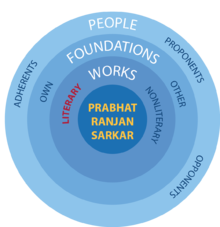Tumi kothay chile kothay thako
Tumi kothay chile kothay thako is the 540th song of Prabhat Ranjan Sarkar's Prabhat Samgiita.[1][2]
| Tumi kothay chile kothay thako | |
|---|---|
 | |
| Music and lyrics by Prabhat Ranjan Sarkar | |
| Song number | 0540 |
| Date | 1983 May 24 |
| Place | Madhukarnika, Anandanagar |
| Theme | Contemplation |
| Lyrics | Bengali |
| Music | Kaharva + Dadra |
| Audio | |
| License |
|
| Location in Sarkarverse | |
Lyrics
| Roman script[nb 1] | Bengali script | Translation |
|---|---|---|
Tumi kotháy chile kotháy tháko |
তুমি কোথায় ছিলে কোথায় থাকো |
Where You've been and where You stay, |
Notes
- ^ For details on the notation, see Roman Bengali transliteration.
- ^ According to the Samsad Bengali-English Dictionary, the word, trasareńu (ত্রসরেণু), has meaning in both physics and philosophy. In terms of physics, it refers to "any of the minute particles of dust appearing to be floating in a stream of light esp. sunlight". In terms of philosophy, it is "a collection of six atoms or three diatoms". As the Bengali book of Prabhat Samgiita[2] prints the word as tryasareńu (ত্র্যসরেণু) and not trasareńu (ত্রসরেণু), this suggests a triangular configuration. In some philosophical circles, the "three diatoms" correspond to the three portions of mind in Ananda Marga spiritual philosophy: citta (crude mental-stuff), ahaḿtattva (subtle mental-stuff), and mahattattva (causal mental-stuff).
- ^ Perhaps this is a reference to the emergence of unit mind in the transition from saiṋcara to pratisaiṋcara in the cycle of creation (as conceived in Ananda Marga spiritual philosophy). Saiṋcara is the analytic phase in which the One becomes many. Pratisaiṋcara is the synthetic phase in which the many individually progress and ultimately merge again with the One.
References
- ^ Sarkar, Prabhat Ranjan (2019) Prabhat Samgiita Songs 501-600 Translated by Acarya Abhidevananda Avadhuta (3rd ed.) Tel Aviv: AmRevolution, Inc. ASIN B082X65YMB ISBN 9781386728276
- ^ a b Sarkar, Prabhat Ranjan (1994) Acarya Vijayananda Avadhuta, ed. Prabhat Samgiita Volume 2 (in Bengali) (2nd ed.) Kolkata: Ananda Marga Publications ISBN 81-7252-084-0
Musical notations
Recordings
- Listen to the song Tumi kothay chile kothay thako sung by Acarya Priyashivananda Avadhuta on Sarkarverse
| Preceded by Bandhu tomar rupera chatay |
Prabhat Samgiita 1983 With: Tumi kothay chile kothay thako |
Succeeded by Mukhar prate niirav kena |
